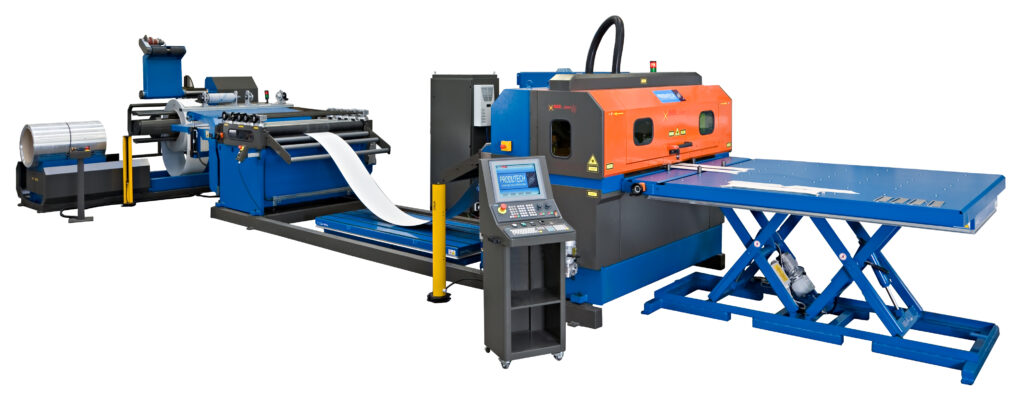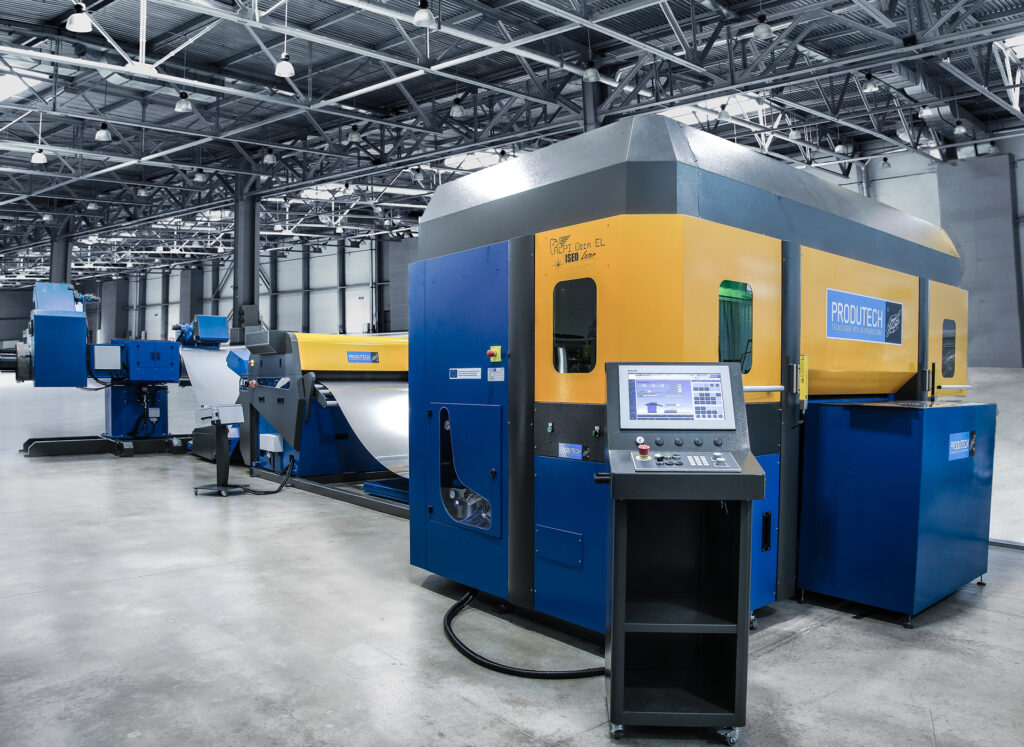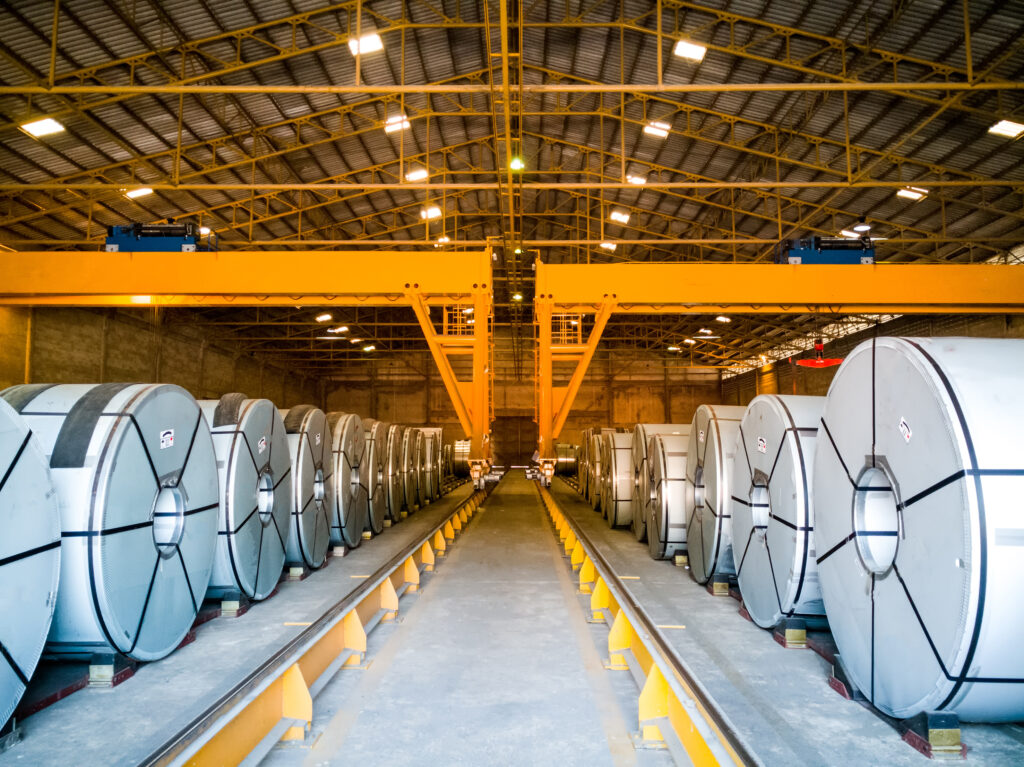These are the cases in which processing thin sheet metal from coil can be highly cost-effective compared to processing it from sheet.
As is well known, sheet metal is a steel product which can be obtained by hot rolling slabs, or by flattening and cutting to length a hot-rolled or cold-rolled strip. In the first case, the sheet comes from “mill,” in the second case from “coil.” The coil, which means “winding,” is therefore a coil of thin metal tape wrapped in a series of windings.
Coils can be industrially processed by means of one or more equipment and machinery arranged in a line, which must unwind and straighten the coils and then process the material; the processes are those typical of sheet metal, i.e. punching, profiling, laser cutting, etc.
Several important advantages…
There are several advantages that can derive from the use of this technology; advantages that we can summarize in some fundamental points.
The first is certainly the possibility to work on automated systems, with high productivity and high speed, with consequent savings in terms of human resources employed. Once the coil has been loaded, the transformation plants do not require constant supervision and can work autonomously for many hours, since – among other things – they are almost always systems equipped with automatic unloading of the pieces. On the contrary, processing from single sheets requires the constant use of qualified personnel for handling, loading, unloading, etc. of the sheet metal.
Another advantageous aspect is the possible economic savings in the purchase of raw materials and the reduced storage space. Coils, in fact, are objects with a very compact shape but made up of a large amount of workable thin sheet metal. Therefore, working from coils instead of sheets allows to occupy a smaller production area inside the workshop.
There is also a final point to be mentioned, which is the reduction of waste: each sheet processed, in fact, generates a certain amount of waste at the head and tail, while the coil, being processed continuously, avoids this type of waste. It is possible to assume that processing from coil results in a reduction in the cost of raw material of up to 15%.
…and aspects to pay attention to
The main obstacle for machine and equipment use that allow coil processing is the quantity to be processed. Naturally, when only a few parts need to be made, sheet metal is the best solution. But even in the case of medium-sized batches, the coil technology is still not very successful, as coil replacement and “production changeover” times are still very high. It is therefore an inflexible technique that is not able to impose itself in those companies where production is very varied and there are frequent changes of material and thickness. However, the most evolved manufacturers of machinery for coil processing have taken considerable steps forward in recent years, devising refined solutions to speed up and streamline coil change operations, making these activities of comparable duration to those involving the removal of a single sheet of metal. Over the next few months/years, these measures will make it possible to increase the diffusion of coil in manufacturing companies; a technology which has enormous potential and, all things considered, is still not very widespread in Italy. It is important to underline that there are also historical and cultural reasons why coil processing is still a “niche” in the panorama of sheet metal processing technologies. In fact, many companies have always been accustomed to working with sheets: they have the relevant technology, and their staff is trained to carry out this type of activity exclusively. The changeover to coil processing, in addition to investments deriving from a serious reflection on production and technology, also requires a change in mentality on the part of specialized personnel; a change that not all companies are prepared to make. However, it is an operating method as mentioned, which in many cases has several advantages over sheet-fed machining and it is no coincidence that it is increasingly used in Italy. A strong impulse to its diffusion has been determined, in recent years, by the introduction of fiber laser cutting on the market. This last technology, in combination with feeding the sheet metal from coil, allows fast and quality cutting of pieces, optimized nesting, with increased flexibility, reduction of costs and energy consumption.
BUILDER’S WORD
Coil: innovation is in the DNA
Since 1993 Produtech S.r.l. of Albano Sant’Alessandro (BG) has been working in the field of design and construction of automatic systems, machines, and special plants; since 2003, it has specialized in the production of plants for processing sheet metal from coil. Produtech exports its machines of recognized quality and high rate of innovation all over the world. Among the most important technologies, it is necessary to mention the fiber laser cutting systems: these are machines that exalt their own characteristics and performances just in case they are enslaved by coils. Fabrizio Mologni, owner of the company, explains: “Our fiber laser cutting machines, called ISEO, in addition to the advantages of coil processing, namely high productivity, optimal material utilization, and more flexible handling of the parts produced ensure continuous cutting of a wide range of metallic materials, including the most reflective ones, namely bronze, copper, brass and aluminum. They also require less maintenance because of its simpler design compared to CO2 laser cutting.”
 Moreover, ISEO machines are equipped with advanced solutions such as the lower suction hood for fumes and scraps that “follow” the laser cutting head. Mologni: “This means that the coil does not need the classic support points, and that there is always a vacuum underneath the cutting area: this solution ensures not only consistently high-quality cuts, because the laser avoids support points, but also more contained and efficient suction, and much reduced maintenance.” That’s not all: all Produtech’s coil fiber laser cutting machines are equipped with direct drive motors on the linear axes and torque motors for shaft and spindle rotation. This makes it possible to eliminate the need for mechanical transmissions and related lubrication, reducing unwanted play and wear over time.
Moreover, ISEO machines are equipped with advanced solutions such as the lower suction hood for fumes and scraps that “follow” the laser cutting head. Mologni: “This means that the coil does not need the classic support points, and that there is always a vacuum underneath the cutting area: this solution ensures not only consistently high-quality cuts, because the laser avoids support points, but also more contained and efficient suction, and much reduced maintenance.” That’s not all: all Produtech’s coil fiber laser cutting machines are equipped with direct drive motors on the linear axes and torque motors for shaft and spindle rotation. This makes it possible to eliminate the need for mechanical transmissions and related lubrication, reducing unwanted play and wear over time.
 Another solution that deserves attention, as it is a very special innovation in the field of coil processing, is the combined “EffiCOIL,” a machine that Produtech has developed to carry out both fiber laser cutting and cold deformation operations using tools and punching. EffiCOIL, therefore, makes it possible to increase the efficiency of those who manufacture sheet metal products by means of cutting and punching, in particular metal structures with fins, joints, ribbing, and special shapes. Fabrizio Mologni concludes: “EffiCOIL was developed through a development project funded by the European Community under the European Horizon 2020 Framework Program for Research and Innovation. It is a machine that unites advantages of the combined punching-laser machine with those typical of coil processing, increasing, in particular, efficiency of the production processes and the logistics within the workshop.”
Another solution that deserves attention, as it is a very special innovation in the field of coil processing, is the combined “EffiCOIL,” a machine that Produtech has developed to carry out both fiber laser cutting and cold deformation operations using tools and punching. EffiCOIL, therefore, makes it possible to increase the efficiency of those who manufacture sheet metal products by means of cutting and punching, in particular metal structures with fins, joints, ribbing, and special shapes. Fabrizio Mologni concludes: “EffiCOIL was developed through a development project funded by the European Community under the European Horizon 2020 Framework Program for Research and Innovation. It is a machine that unites advantages of the combined punching-laser machine with those typical of coil processing, increasing, in particular, efficiency of the production processes and the logistics within the workshop.”




